- History of Sherpa
- Sherpa Genetic
- Mountaineering
- Beyond the Mountains: Sherpas as Entrepreneurs
- Religion of Sherpa
- Sherpa Clothing
- Sherpa Homes: Traditional Architecture and Way of Life
- Notable Sherpa People
- Sherpa Culture:
- Language: The Voice of the Sherpa People
- Interesting Facts About Sherpas
- Sherpas and Their Deep Connection to Everest
Sherpas are a well-known ethnic group of Nepal descended from early Tibetan settlers who migrated to Nepal’s mountainous regions of Solukhumbu. Some sherpa communities are also in Bhutan and India, specifically in West Bengal (Kalimpong) and Sikkim (Darjeeling). In Tibet, they are mainly located in Tingri County, which shares proximity to Nepal’s northern borders. Sherpa means ‘easterners,’ which indicates their ancestors who were Tibetans from the Kham region in Eastern Tibet. Sherpas live in Nepal's eastern region close to the Tibetan border in the north, such as Solukhumbu, Kama, Khatra, Rolwaling, Pharak, and Barun valleys. Some live in Dolakha’s Bigu and Sindupalchok’s Helambu villages as well.
Being Buddhists of Tibetan origin, they practice Tibetan Buddhism, adhering to the Nyingma sect. The Tengboche Monastery of Khumjung in Solukhumbu district is the most significant monastery of Sherpas; built in 1916 it is the first celibate monastery of the region. Similarly, the Sherpa language, a part of the Tibeto-Burman Languages, is quite similar to Eastern and central Tibet dialects.
Known worldwide for their extraordinary mountaineering skills, sherpas have made immense contributions to expeditions in Nepal’s Himalayas, playing crucial roles in many successful summits. Beginning with Tenzing Norgay Sherpa, who first summited Mt Everest with Sir Edmund Hilary on May 29, 1953, this resilient community has repeatedly proved their merit.
Following the trend of migrating to first-world countries, sherpa communities have also migrated to different parts of the world for better prospects. According to a recent study, there are around 11,000 sherpas in New York City alone.
The 2023 census of Nepal states that there are 250,637 sherpas in Nepal, about 1.1% of the total population.
History of Sherpa
Sherpas are descendants of early Tibetan settlers from Eastern Tibet who migrated to Nepal’s Solu and Khumbu regions of Mahalangur Himal in the 13th and 14th centuries. It is believed that following religious conflicts with Mahayana Buddhism, they moved south of Tibet, seeking refuge elsewhere, and ended up in the Himalayan valleys.
According to Sherpa’s oral history, four significant clans migrated to Solukhumbu from Tibet’s Kham province. They were Minyakpa, Lamasherwa, Thimmi and Chawa. Over time, these significant clans proliferated into more than 20 sub-groups that comprised about 1.1% of Nepal’s population.
Around the 15th century, Sherpas of the Khumbu region successfully established a flourishing settlement for themselves, which depended solely on agriculture, trade, and animal husbandry. They traded rice, wool, and salt to Tibet using yaks for transportation. The preferred trade route was through Nangpa La Pass (5,716 m), which connects Nepal and Tibet. Traditionally, Sherpas engaged in rearing cows and yaks for food and transportation. They cultivated highland crops like buckwheat, potato, and barley.
Due to changes in China’s political scenario in the 1960s, the diplomatic relations between Nepal and China underwent further changes. It leads to a stronger government influence on the sherpa communities of the Solukhumbu region. Moreover, Sagarmatha National Park’s establishment brought about an unprecedented surge in trekking expeditions in Khumbu. It enabled a shift from traditional subsistence practices like agriculture, trade, and animal rearing to mountaineering and tourism as the community’s primary income source. It also made the sherpas renowned worldwide for their high-mountain climbing expertise.
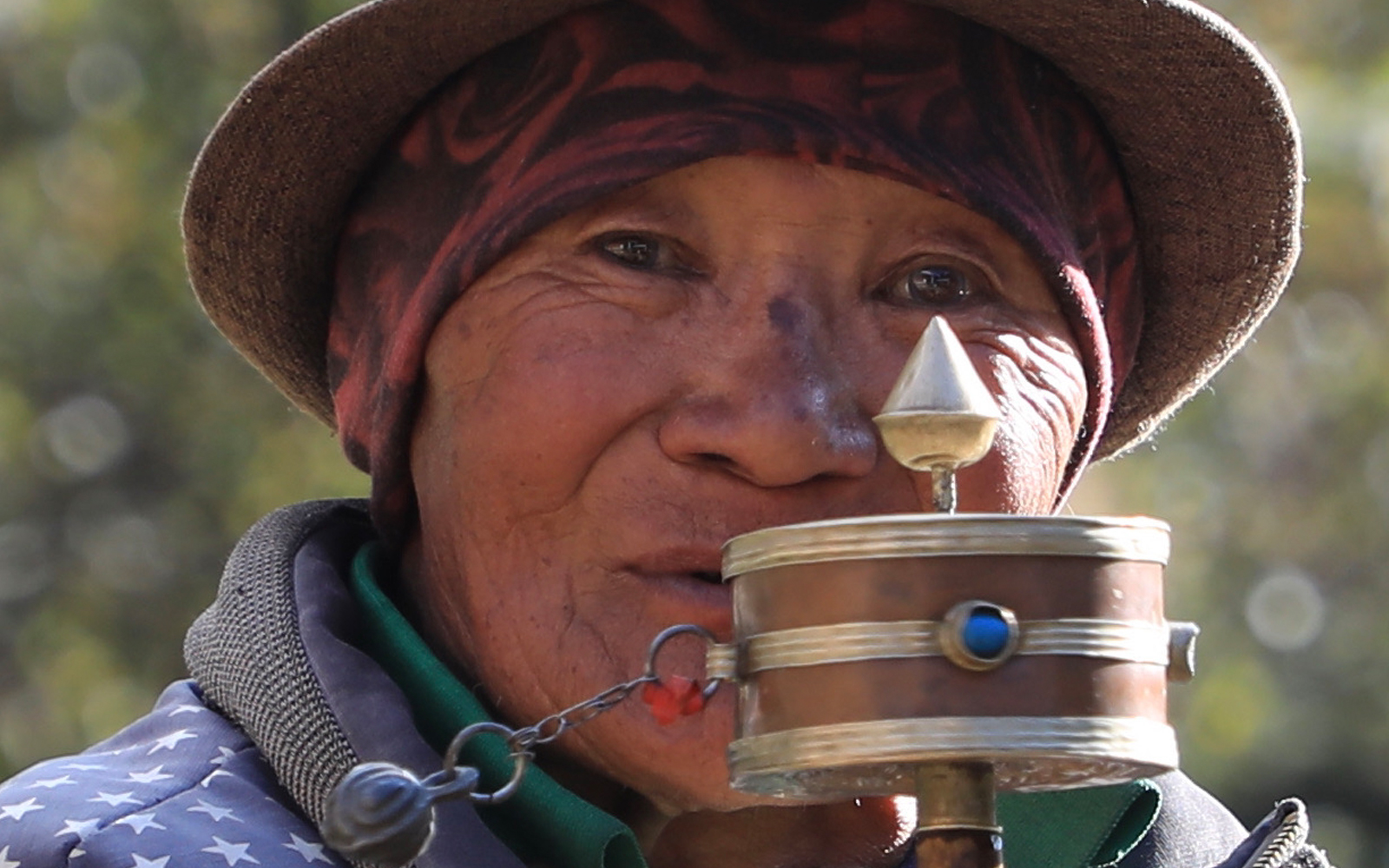
Sherpa Genetic
Studies have found that Sherpas’s genetic traits are similar to those of Tibetans, which is likely as they are descendants of people from Tibet’s eastern province of Kham. This genetic trait enables them to survive in the Himalayas’ high altitudes without much hassle and explains how they can easily carry out mountaineering feats.
Research of Sherpa’s parental lineage reveals that their Y-chromosome and mitochondrial DNA are similar to that of Tibetans of Tibet, hence, the common ancestry. This explains why Sherpa looks distinct from the rest of Nepal’s population.
Hemoglobin Adaptation
At high altitudes, oxygen levels plummet so low that it becomes hard to survive without proper preparations. People living in lowlands will find it difficult to adjust to extreme elevations if their bodies fail to make more red blood cells to handle the low oxygen levels. On the other hand, the sherpas and Tibetans are genetically equipped, enabling their bodies to manage hemoglobin production more efficiently, thus contributing to a more effective use of oxygen. This genetic factor is called EPAS1, more commonly known as the super-athlete-gene. It reduces the excessive production of red blood cells, which could lead to thickened blood and other health-related complications.
Genetic Diversity and Affinity
The allele frequencies found in Tibeto-Burman populations are also found in Sherpas, which makes them a part of the broader genetic heritage. This trait is generally apparent in the Himalayas and Tibetan Plateau populations. Genetic isolation over the years has resulted in minimal gene flow from other Nepalese populations and, hence, has preserved Sherpa’s distinct identity.
Genetic Divergence
The genetic divergence of Sherpas from Tibetans is estimated to be less than 1,500 years. So, it is a recently derived sub-lineage of Tibetans, which explains the physiological similarities, especially the traits that enable them to survive in high altitudes.
Genetic Ancestry
Apart from the fact that Sherpas share genetic traits with their Tibetan ancestors, centuries of gradual adaptation also shaped the Sherpa genetics, enabling them to become well-suited for surviving at extreme altitudes. Hence, experience and genetic adaptations made sherpas the most suitable people for mountaineering activities at extreme altitudes.
Mountaineering
Sherpas are resilient people who have dwelled in the shadow of the world’s tallest mountain - Everest (8,849 m), for centuries, making it their home away from home. After the ancestors migrated to Nepal’s Khumbu and Solu regions, they practiced subsistence agriculture and trade to survive in these harsh highlands. One might marvel at their resilience and bravery, wondering how they became so. It is simply because they have lived in these high mountains for centuries, adapting to the thin and extreme environments. Similarly, they have tread these steep trails regularly even before mountaineering became famous in Nepal.
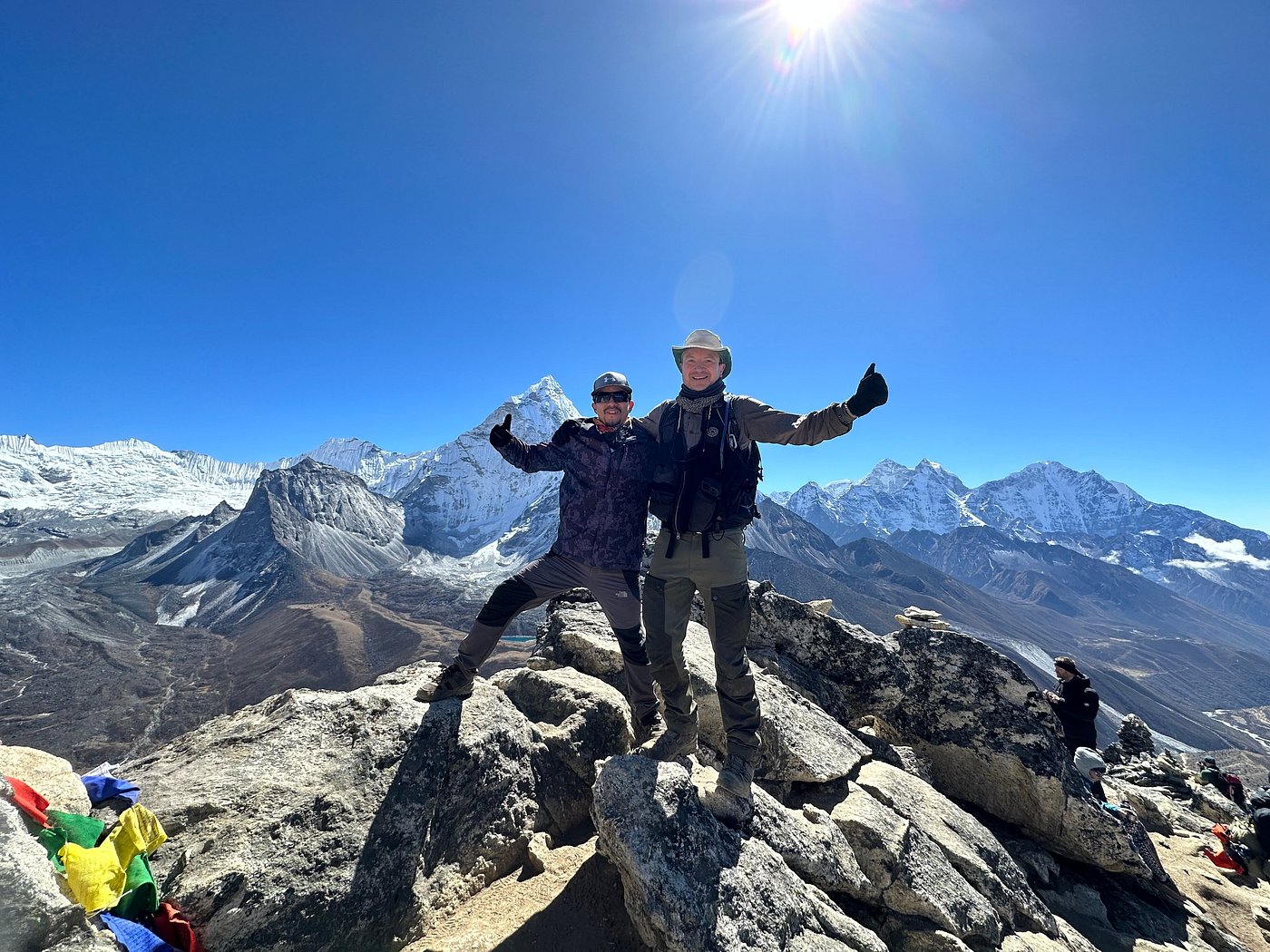
Mountains are sacred entities for sherpas. Having lived their whole lives in the lap of Mt Everest, they worship it as their god and protector. Before every ascend of Chongmolangma (sherpa term for Everest), they perform rituals to seek blessings from mountain gods. Their unwavering faith makes most of their attempts at summiting Everest successful, as they climb with sincerity and respect rather than the mindset of conquering it.
A significant feature of sherpa genetics that makes them more adaptable in higher elevations is the hemoglobin binding ability of their genes and the increased nitric oxide production. Unlike people of lowlands who can barely function in Everest’s thin air, sherpas can naturally adapt and even perform strenuous activities like carrying massive loads.
At the beginning of the 20th century, Western explorers made numerous attempts to summit the world’s highest mountain - Everest (8,849 m) from Nepal’s side. They hired sherpas to assist them in these daring feats and soon realized that without sherpas, who not only guided them on the trails but also helped in carrying their supplies and setting ropes, their expeditions would not be possible.
Sherpa’s growing reputation as the backbone of Himalayan mountaineering gained further recognition with the first successful summit of Mt Everest by Tenzing Norgay Sherpa and Sir Edmund Hillary on May 29, 1953. Since that historical moment, sherpas have been on the frontline of high-altitude treks, braving the most dangerous parts of the mountains. They are the first to tread dangerous routes like the Khumbu Icefalls to ensure climbers’ safety by risking their lives. They carry supplies and equipment so the climbers can realize their dream of summiting Everest.
With the growing fame of sherpas as dedicated and diligent guides of Everest expeditions, a few misconceptions have also emerged. Those unfamiliar with the sherpa community tend to think that all the mountain guides of Nepal are called ‘sherpa.’ They must know that sherpas are a unique ethnic group in Nepal and have their own language, history, and culture.
Sherpa Salary and Mountaineering Role
A rough estimate of how much a sherpa earns for the hazardous service of guiding expeditions to Everest is around 4,000 to 6,000 USD per climbing season. It may appear higher than the average salary of Nepal, but considering the risk they take and when compared to the wage earned by Western guides ($50,000 per expedition), this is a meager amount.
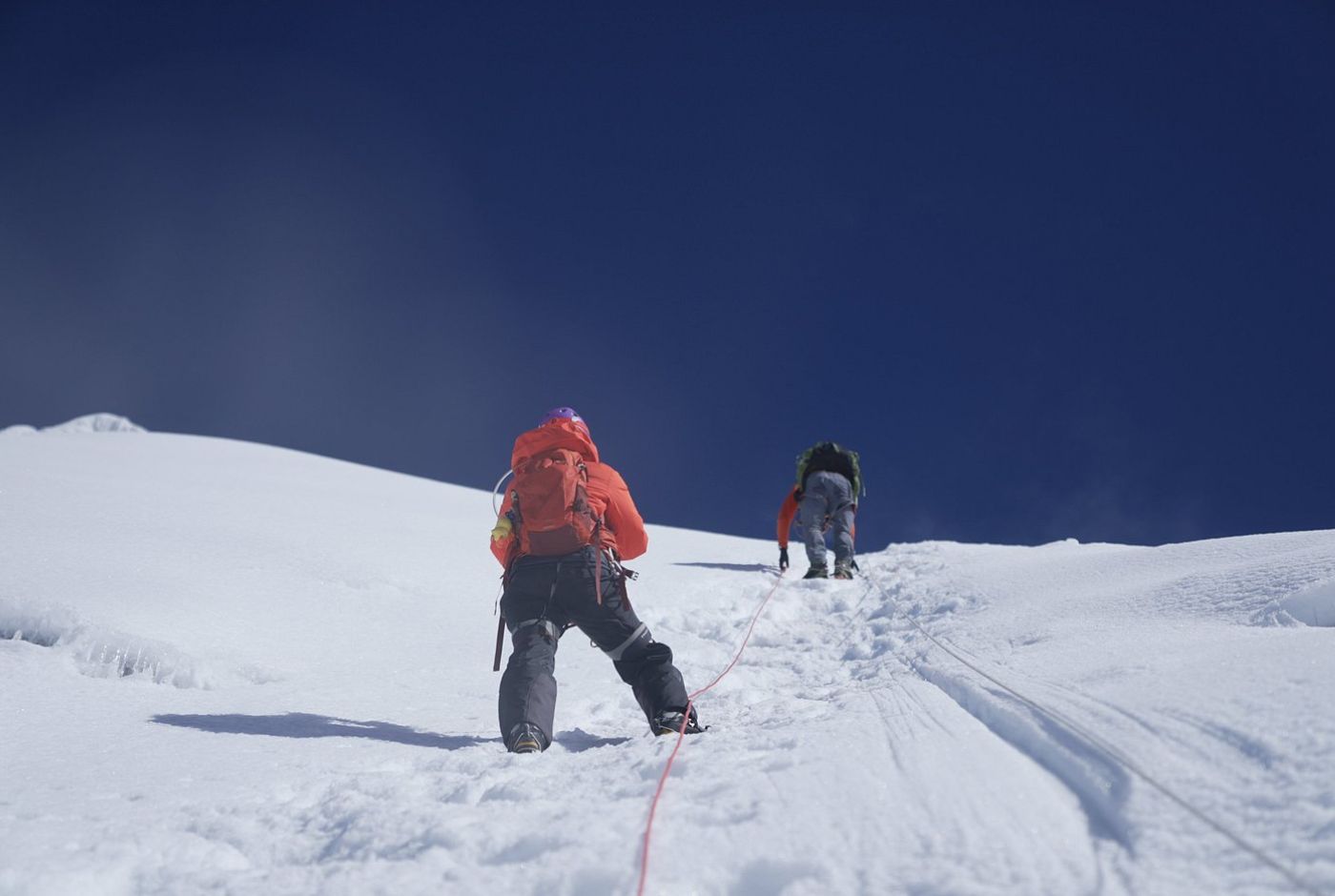
Why the Disparity in Pay?
Despite performing perilous and arduous work in the mountains, sherpas often get underpaid due to the exploitative nature of adventure tourism businesses. Moreover, Western-dominated guiding companies mostly hire sherpas for their expeditions, using their mountaineering expertise. However, while compensating, they pay them only a fraction of the amount foreign guides earn for the same service.
What Do Sherpas Do on Everest?
Sherpas are aptly called the backbone of Everest expeditions. They perform some of the most arduous jobs to ensure the climber’s safety on these perilous trails. It would suffice to say that most climbers would not have made it to Everest’s summit without their assistance. Their work includes:
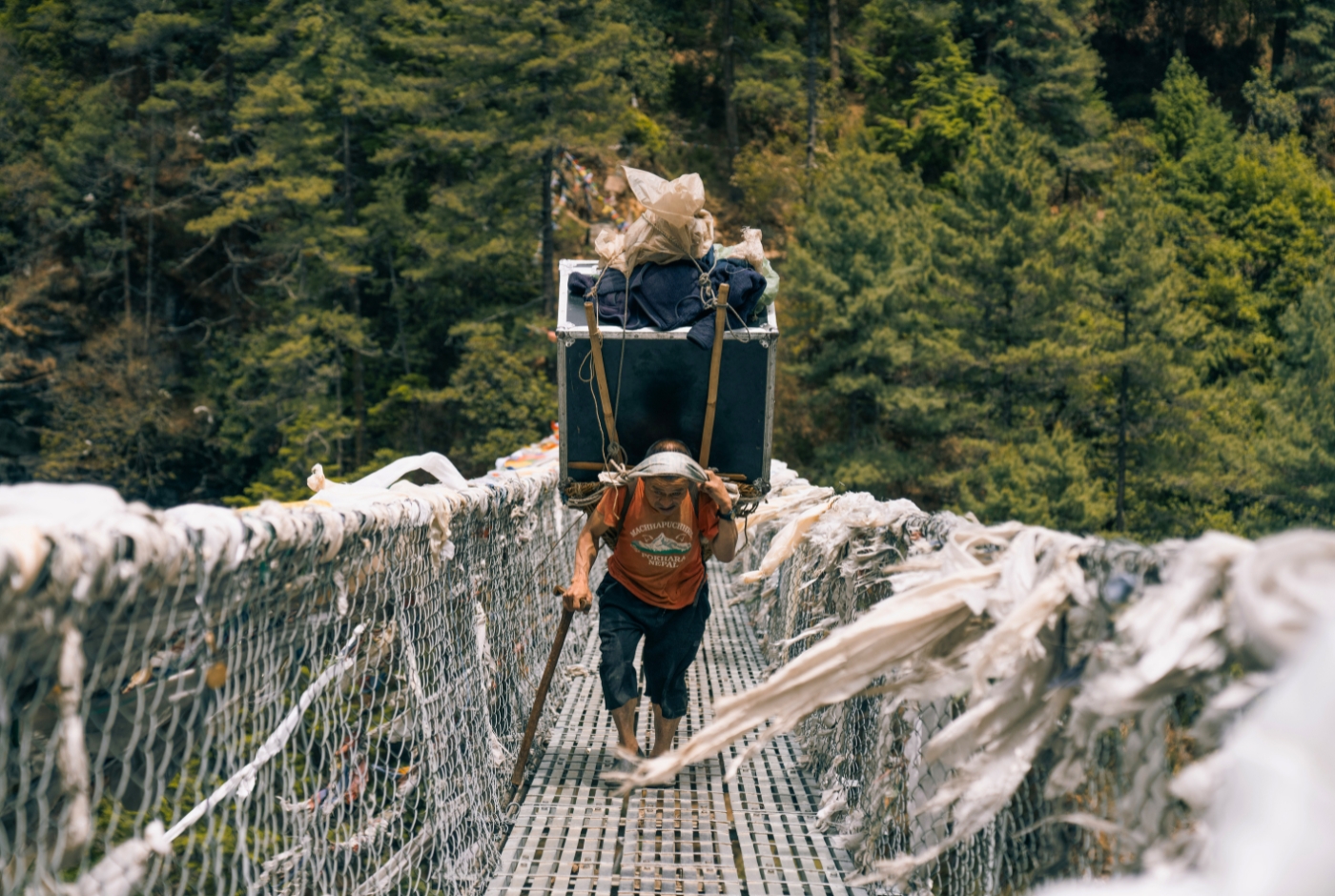
Carrying heavy supplies like oxygen tanks, ropes, tents, and food. Making prior preparations like transporting gears from Base Camp to higher-altitude camps. They make 20-25 round trips to prepare for the higher camps before the climbers’ arrival.They risk their lives to fix ropes and ladders for climbers at some of the most treacherous sections on the trails, like that of Khumbu Icefall, Hillary Step, and others.Ensuring climbers’ safety by assisting them through disaster-prone zones like avalanche paths, icy trails, and any other sections where mishaps occur due to sudden weather changes.Providing moral and physical support to climbers at extreme altitudes while leading them to the summitCarrying out highly responsible yet risky jobs like taking split-second decisions when faced with life-or-death situations involving climbers’ lives.
Beyond the Mountains: Sherpas as Entrepreneurs
Sherpas have invested their earnings in other ventures to ensure a brighter future for their families and the community. Many have started running lodges, trek companies, and other mountaineering-related businesses, such as trekking gear stores. Apart from helping their extended families financially, they have also contributed to developing their villages’ infrastructures.
Despite these new ventures and the risks involved in guiding on Everest, guiding remains a lucrative option for most of them because of its relatively higher income than other jobs.
The Cost of Climbing Everest
A guided summit climb will cost anywhere between 30,000 to 120,000 USD. The cost depends on the guiding company you choose, the support you receive, and the logistics. It is apparent that climbers pay incredibly high fees for their Everest expeditions, but the sherpas, who do the most challenging and risky job on these expeditions, receive only a fraction of the amount paid by climbers. The economic disparity existing in the mountaineering industry is evident from here.
Religion of Sherpa
As descendants of Tibetans from Eastern Tibet, sherpas are Buddhists practicing Tibetan Buddhism and some forms of animism and shamanism. They are a highly religious ethnic group with great regard for Mother Nature. For them, all aspects of nature are abodes of holy spirits, so they must pay homage to them to attain their blessings. Being spiritual people guided by beliefs of compassion and nonviolence, they refrain from harming others and live a decent life guided by their Buddhist beliefs.
Tibetan Buddhism has various sects, such as Nyingma, Sakya, Kagyu, and Geluk. Sherpas of Nepal follow the Nyingma sect, so they are called Nyingmapa. It is the oldest form of Tibetan Buddhism, founded by Guru Padmasambhava in the 8th century. The Nyingma school of Tibetan Buddhism is also called the Red Hat sect. Its salient features are meditation, hidden treasures, obscured religious teachings and objects that will be retrieved appropriately, and mysticism.
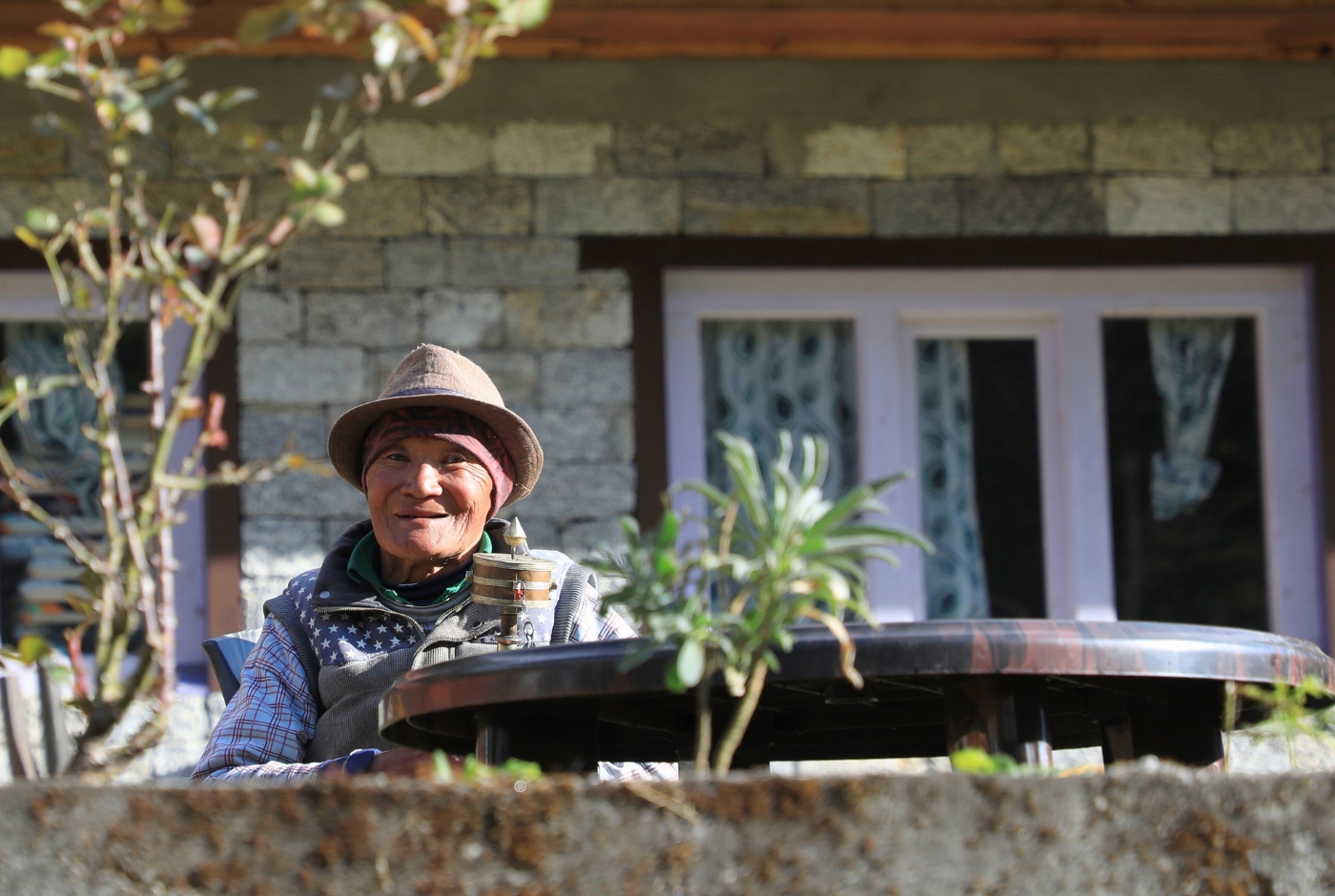
Monasteries or gompas, known in the Sherpa language, are prominent structures central to Sherpa’s religious culture. They are the places of worship for their community and often the abodes of monastics. Some monks and nuns chose to live outside the monasteries but away from their families, dedicating their lives to religious practices. A unique feature of Nyingmapas is that their lamas (spiritual teachers) can choose celibacy or remain householders. They can still perform religious ceremonies and guide their community on the path of Buddhism, irrespective of their marital status.
For sherpas, the mountains are abodes of gods and spirits, so they must be revered and treated with utmost respect. Their belief system also includes nature, so they regard Mt Everest as the ‘goddess mother of the world.’ Other gigantic peaks are associated with deities; for instance, Mt Makalu is associated with Shiva. Likewise, sherpa communities worship specific mountains as their protectors.
One of the significant sherpas festivals is Mani Rimdu. It commemorates Guru Padmasambhava’s introduction of Buddhism in Tibet. With sacred ritual dances, mani rimdu introduces the mystical elements of the Nyingma religion while reinforcing the presence of divine forces.
As the Sherpa religion is the oldest school of Tibetan Buddhism, it possesses traits of animism and shamanism, which greatly influence their daily lives. They believe that nature has guardian spirits protecting its entities, and they must be pacified through worship. To maintain a harmonious balance with Mother Nature, sherpas regularly perform rituals for mountains, trees, rivers, etc.
Lhawa (shamans) and mindung (soothsayers) are significant figures of the Sherpa religion. They are the mediums who can connect with spirits, read into omens, and interpret the supernatural causes of illnesses. In Sherpa society, laws and bindings are revered figures who maintain a harmonious balance between the physical and spiritual worlds and protect their people from harm and misfortune.
Another significant feature of Nyingmapas is their belief in reincarnation. They believe that when a spiritual guru passes away, they are re-born as incarnations of their past self and, thus, continue the cycle of passing on wisdom from this life to the next.
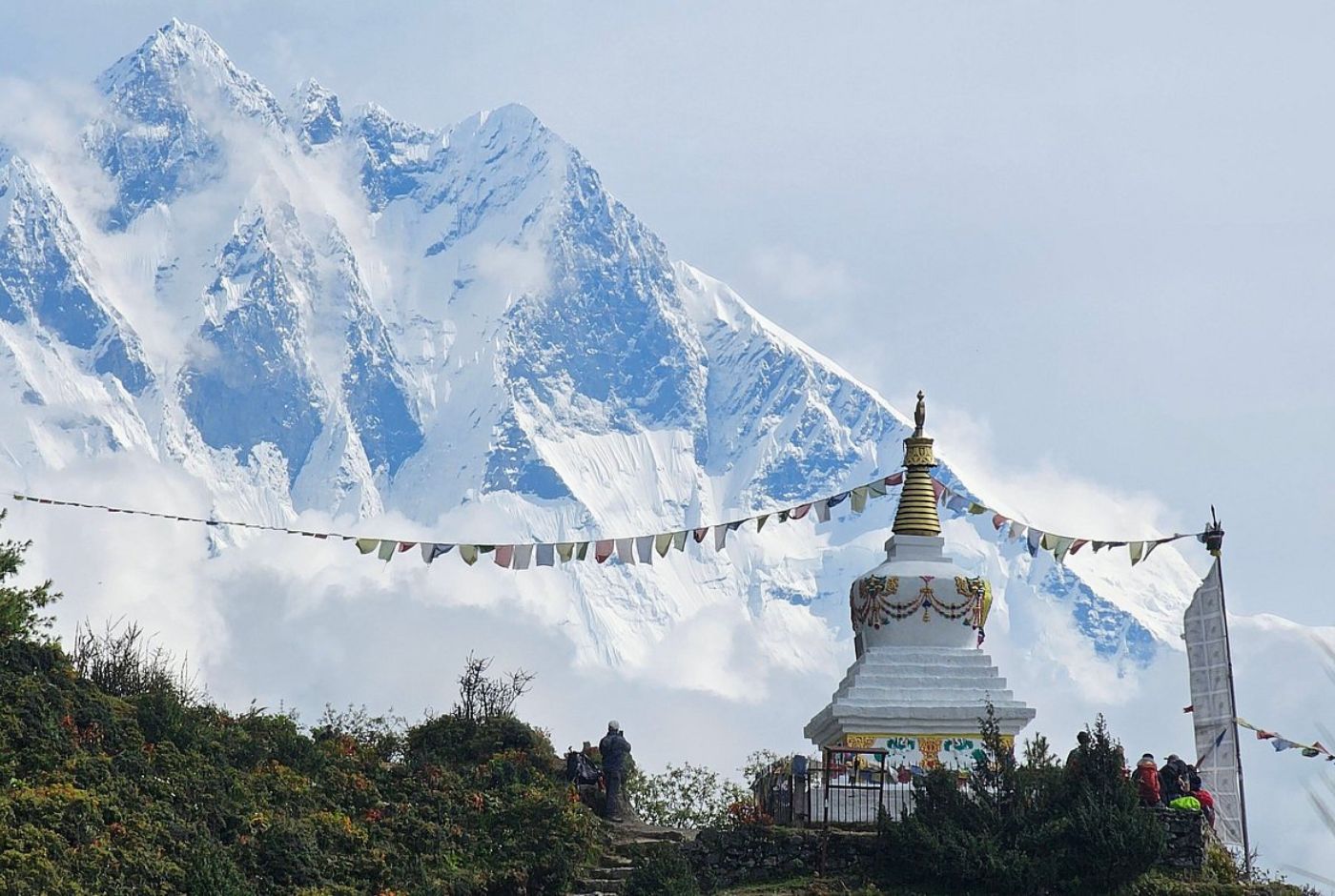
Sherpa Clothing
Traditional sherpa clothes, ‘chuba,’ closely resemble Tibetan traditional dresses due to their shared ancestry. Chubas are generally made from home-spun wool and sheepskin variants for their warmth and durability. Men’s chuba are long-sleeved robes with the hemline falling just beneath the knee. It is tied with a cloth sash at the waist (kara). The upper part of men’s chuba is kept loose so that the pouch-like fold in the front (namdok) can carry small items. Undergarments for men include a blouse (raatuk), a stiff collared shirt (tetung), and a pair of trousers (kanam).
Sherpa women’s traditional dresses are also called chuba. They used to be made from home-spun wools. The women’s robes feature full-length and long-sleeved dresses (tongkok). Another variant includes sleeveless dresses (aangi), which are worn over a full-sleeved shirt (honju) and a blouse (raatuk). A unique addition to the traditional dress of sherpa women is the pangden (colorful striped apron), which is worn in the front, and gewe or gyabtil, which is worn in the back. A married woman generally wears Pangden, which symbolizes a woman’s marital status. Women’s chuba robes are held together by a cloth sash (kara) tied around the waist. Then, a traditional belt called kyetig (a silver buckle) is worn on top of the cloth sash.
Traditional chubas are gradually giving way to modern readymade clothing. Especially while working in the mountains, sherpas now prefer trekking-friendly clothes as they are more convenient than chubas. These days, younger generations wear chubas only during festivals and rituals.
Sherpa Fabric and Modern Clothing
Sherpa fabric is a popular material used for mountain wear. It is a synthetic material made from acrylic or polyester, commonly known as faux shearling. Resembling the authentic materials of Sherpa traditional clothes like wool and sheep skin, the faux shearling is excellent for providing insulation and warmth.
Sherpa fabric is smooth on the outside and bumpy on the inside. It traps warm air so that the wearer can get maximum insulation. You can find several clothing items and footwear made from sherpa fabric. There are sweaters and jackets, hats, boots, mittens, and even blankets and sweatpants. The fabric is used for furniture also, specially to make upholsteries.
Sherpa Adventure Gear and Modern Apparel
Following the recognition of the Sherpa community, they have become a popular brand in Nepal. Sherpa Adventure Gear is a Nepali brand specializing in outdoor apparel like sherpa jackets, insulating and high-performing trekking wear, trekking gear, etc. Check out popular outlets like Sherpa Adventure Gear Nepal and Sherpa Adventure Gear Kathmandu for high-quality mountaineering clothes and gear.
Sherpa Jackets and Pricing in Nepal
Sherpa jackets are the first choice of trekkers and climbers due to their comfort, warmth, and durability. A Sherpa fleece-lined jacket mimics clothing made of natural wool and is ideal for cold temperatures. You can find a variety of Sherpa fleece-lined clothing in Nepal with varying price ranges depending on the materials used and their brands. There are Sherpa vests and hoodies, sherpa denim and leather jackets, sherpa coats, and many more. Another factor that determines sherpa jackets’ price is whether they are made from wool, synthetic fleece, or high-quality adventure gear materials.
Sherpa clothing reflects the rich culture and heritage of the Sherpa community while also carving out a niche for itself in the global fashion trends.
Modern Influence on Sherpa Clothing
With modernization, even remote places in Nepal have seen some favorable changes. Home-spun wool and silk, which used to be the only materials used in communities for cloth making, are now replaced by synthetic factory-made fabrics. Modern trekking clothes are chosen over traditional clothes by community members working as mountain guides. Hence, fleece jackets and insulated trekking garments are becoming more popular among these groups. Traditional chubas, however, still have an essential role in the sherpa culture. They are worn during festivals, cultural events, and religious ceremonies.
Sherpa fabric has also gained immense popularity in the fashion industry due to its soft fleece-like material. There are Sherpa fleece jackets, sweaters, hats, mittens, blankets, upholstery, and many more.
Sherpa Homes: Traditional Architecture and Way of Life
Sherpa homes are simple two-story structures made of wooden frameworks. They are apt for Himalaya’s harsh climates and have practical setups. Made from locally sourced materials, they reflect Sherpa customs and beliefs.
Construction and Layout
These two-story houses have practical purposes and serve all the accommodation needs of high-altitude accommodation. The ground floor is a storage area for livestock. Food supplies, firewood, and other household stuff that are rarely used are stored here so that the main living area (upper floor) can be spacious and clutter-free. The ground floor also helps to insulate the upper floor by keeping it aloft.
The upper floor of Sherpa homes is the main living quarters. It serves as the living area as well as the bedroom.
In terms of structure, the two-level design with a wooden framework is most suitable for these hilly regions. Heavy stones are placed on the flat wooden roofs to ensure strong mountain winds do not blow them away. In heavy snowfall areas, the roofs are slanted to avoid seepage. Gaps are made in the roof to make an outlet for smoke emitting from indoor fires.
Features of Sherpa Homes
Sherpa homes are cozy traditional houses with all the basic requirements for a comfortable stay. As they are highly religious, they prioritize assigning a prayer room in their house, which is the best room. Wealthy families have grand shrine annexes to keep the idols of their deities and for other religious practices. Prayer rooms have Buddhist idols, scriptures, ritual objects, and daily offerings.
The living room is the central area of the house. There is a fire pit in the center, where meals are cooked, and families gather to have meals or just lounge in the cozy room. There is little to no traditional furniture; they use platforms and benches. For insulation, they cover their floors with rugs and carpets.
Toilets are very simple in sherpa houses. They either have a small corner in the house for a latrine or can be located outside the house. They generally use the waste from the toilet to make compost.
Community and House-Building Traditions
An interesting feature of the Sherpa community is their house-building tradition. It is their custom to help a newly married couple build their house. When a man marries and begins his married life, all the neighbors join in to make a separate house for his family. Not only do they physically contribute by doing labor, but they also provide food and beverages for everyone involved in the construction.
This endearing communal effort brings the community closer and strengthens their bonds. Religious ceremonies are performed at each phase of the building process to bring harmony and appease the spiritual beings. These homes have spaces for animals, humans, and their deities. Such houses are passed down from one generation to another to preserve the ancestral ties.
Adaptations and Modern Changes
Modern housing materials are now being incorporated into building houses by wealthy sherpas. While the traditional structure remains the same, they use imported metal roofing and other modern materials for their efficient insulation properties and durability.
Sherpa houses in modern days, though altered in some cases due to the use of new construction materials, still possess the harmonious blend of nature, religious values, and their sense of community.
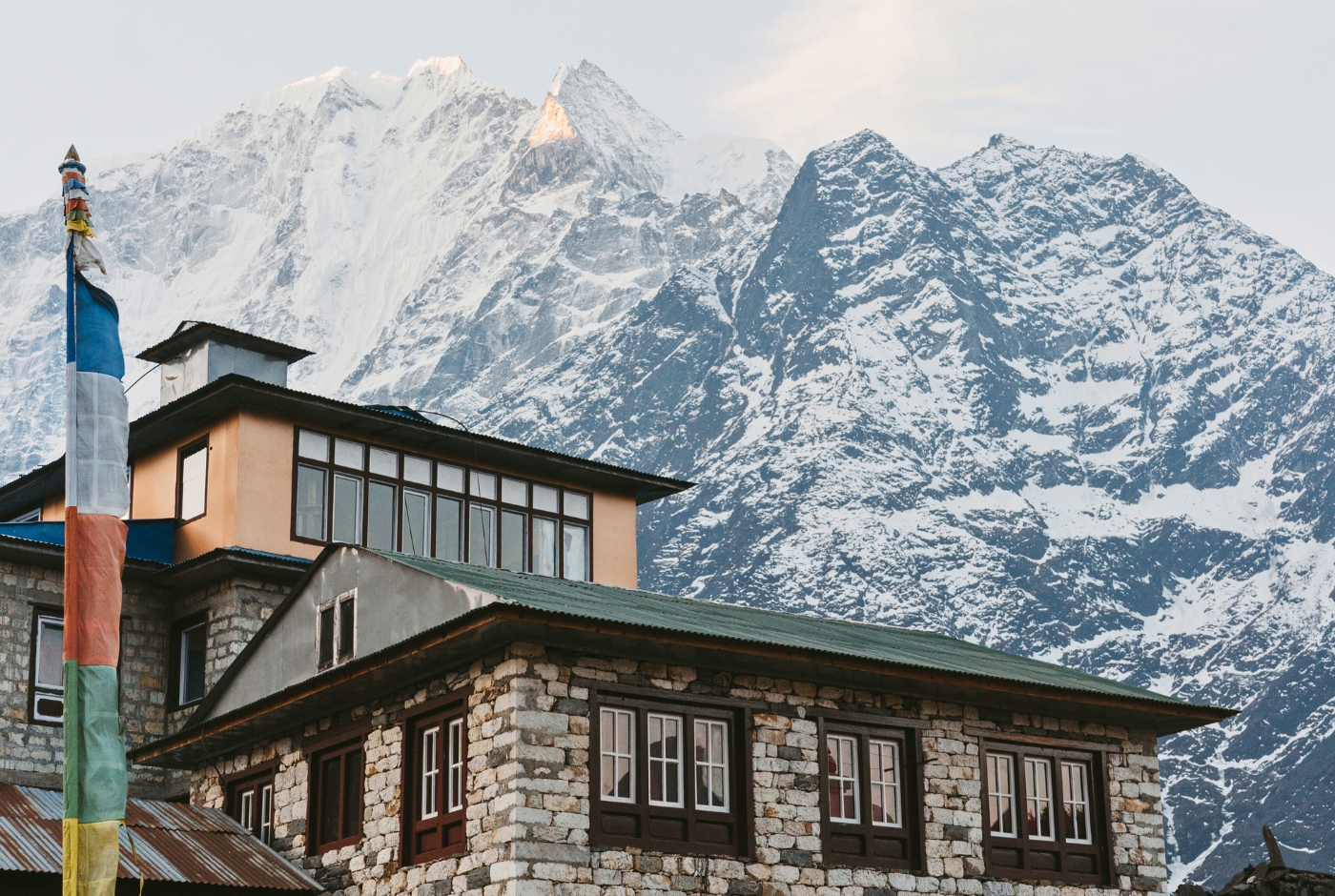
Notable Sherpa People
Since 1953, after the first summit of Mt Everest, the sherpa community has garnered fame and recognition worldwide as irreplaceable guides of Himalayan expeditions. Over the years, they have set many records in mountaineering and contributed to other fields, such as sports, politics, and diplomacy.
Tenzing Norgay (May 29, 1914 - May 9, 1986)
The legendary Tenzing Norgay Sherpa from Nepal was a key member of the British expedition to Mt Everest in 1953. In recorded history, he and Sir Edmund Hillary are the first summiteers of Mt Everest. He has since become a global icon, and his legacy remains due to his bravery, hard work, and lifelong contribution to mountaineering.
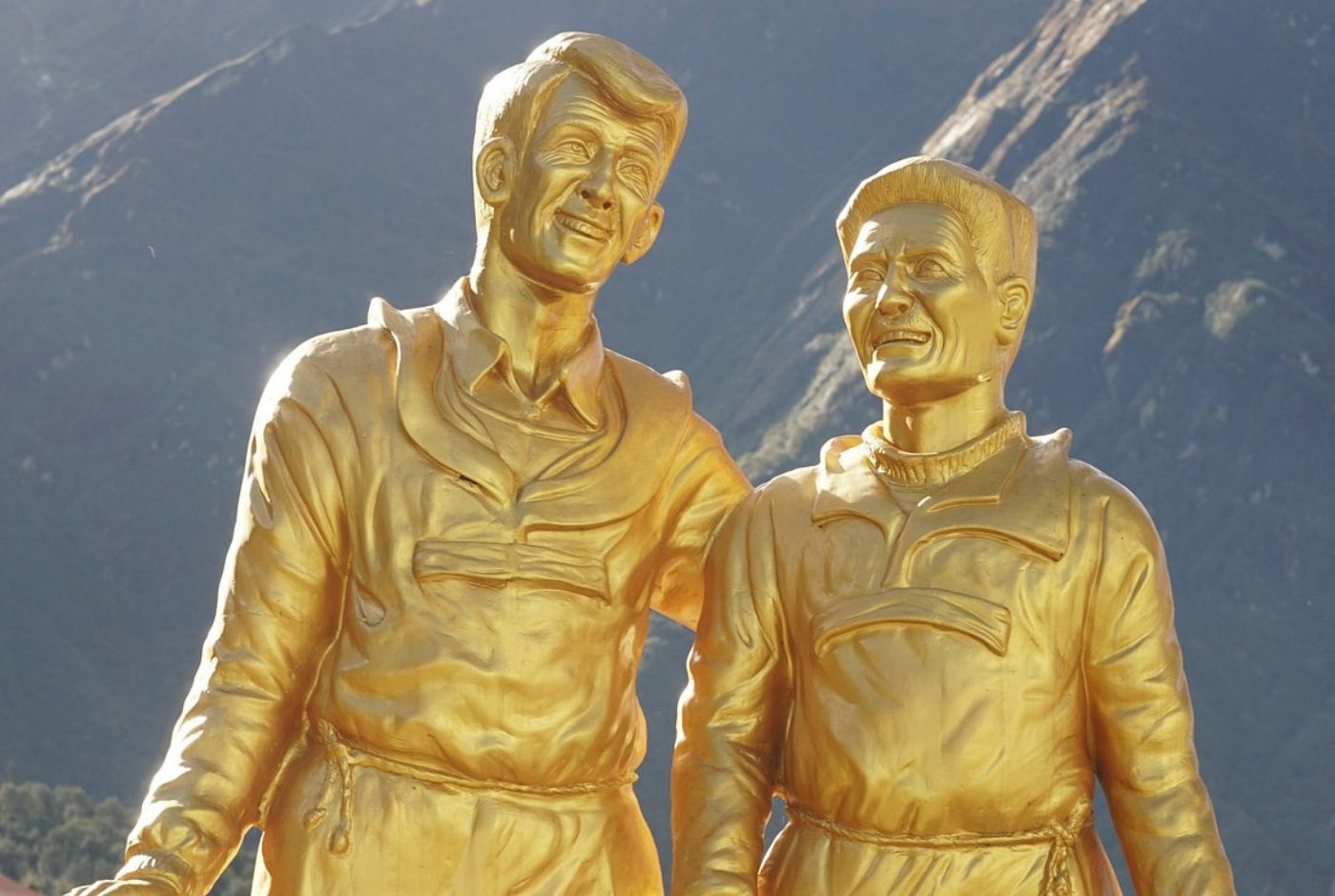
Pasang Lhamu Sherpa (Dec 10, 1961 - Apr 22, 1993)
Pasang Lhamu Sherpa became an iconic figure in mountaineering after her ascent of Mt Everest on April 22, 1993. She was the first Nepalese woman to accomplish this feat by sheer perseverance and courage. She has inspired women climbers all around the world. Unfortunately, on her descent from the summit on the said expedition, a sudden change in weather resulted in her untimely death.
Apa Sherpa (January 20, 1960 -)
Apa Sherpa was the record holder with the most ascents of Mt Everest till 2018. A zealous sherpa guide who rose from humble beginnings, he made 21 successful summits of Everest. Beginning his career as a porter and cook on various Himalayan expeditions, he later became a reputed guide and climber on Everest expeditions.
Kami Rita Sherpa (Jan 17, 1970 - )
Kami Rita Sherpa, the record holder for most successful ascents of Mt Everest, made his 30th ascent on May 22, 2024. A modern-day mountaineering legend, Kami Rita has shown exceptional skills in high-altitude climbing.
The Everest man does it Again: Kami Rita Sherpa scales Mount Everest for the 30th time
Kami Rita, who has earned the nickname “The Everest Man,” belongs to the ethnic community of the Sherpa. In past interviews, he stated that he had never set out to break records but has been “just working” all these years. Read more
Babu Chiri Sherpa (June 22, 1965 - April 29, 2001)
Babu Chiri Sherpa was an exceptional mountaineer. He had reached the summit of Mt Everest 10 times by the age of 35. His daring feats on the Himalayas are awe-inspiring and praiseworthy.
He spent a night at Everest’s summit (21 hours) without using any oxygen tanks in May 1999! It was recorded in the Guinness World Records. Another World Record made by Babu Chiri is the fastest summit of Mt Everest. He accomplished this feat in just 16 hours and 56 minutes.
His untimely death left the mountaineering fraternity devastated. On April 29, 2001, while on his way to the summit for the 11th time, he fell into a crevasse and passed away.
Lhakpa Sherpa (1973 -)
Lhakpa Sherpa is an iconic figure of Everest expeditions. She is the first Nepali woman to ascend and descend from Everest’s summit. She accomplished this feat in the year 2000. Thereon, she scaled Everest a whopping 10 times! Her 10th ascent of Everest on May 12, 2022, was crowdfunded. She also made it to the list of BBC’s 100 Women in 2016. Lhakpa continues to inspire female climbers worldwide, having shattered the gender barrier in mountaineering.
Mingma Dorchi Sherpa (Aug 18, 1987)
Regarding speed climbing in the Himalayas, Mingma Dorchi Sherpa of Nepal’s Sankhuwasabha district is, without doubt, the most striking figure. A young Himalayan guide and mountaineer, he has made a Guinness World Record by scaling the summits of Mt Everest and Mt Lhotse within 6 hours and 1 minute! He has been nicknamed the ‘speed demon.’
Other Notable Sherpas
- Jamling Tenzing Norgay (April 23, 1965 - ) - Son of the renowned Tenzing Norgay Sherpa. He is a mountaineer and expedition leader.Temba Tsheri (May 9, 1985 - ) - The youngest to summit Mt Everest in 2001. He was just 16 years old.Lhakpa GelMay 9rpa (June 23, 1967 - ) - He has achieved the fastest ascend of Mt Everest (10 hrs 56 mins).
- Pemba Doma June 23 (July 7, 1970 - May 22, 2007) - She was the first Nepalese woman to climb Mt Everest from its North side (Tibet). She has ascended the summit twice, each from the north and the south side.
- Mingma Gyabu Sherpa (June 16, 1976 - ) - He became the first mountaineer of Nepal and South Asia to successfully summit the 14 Eight Thousand Plus peaks.Lakpa Tsheri Sherpa - An award winner of National Geographic Adventurer of the Year 2012.
- Lhakpa Tsheri Sherpa is famous for “The Ultimate Descent,” where he and Sano Babu Sunuwar (kayaker) first ascended the summit of Mt Everest and then paraglided over the Himalayas. After paragliding, they paddled from the Koshi River to the Bay of Bengal in India, completing the entire descent successfully.
- Nimdoma Sherpa (1991 - ) - She became the youngest woman to climb Mt Everest in 2008. She was 16 years old. The latest record holder for this category is Malavath Poorna from India.Chhurim Sherpa (1984 - ) - She holds the Guinness World record for scaling Everest twice in a season, i.e., on May 12 and May 19 of 2012.
- Chhang Dawa Sherpa (July 30, 1982 - ) held the record of being the youngest climber to ascend all the 14 thousander peaks of the world till 2019. He and his brother (Mingma Sherpa) hold the Guinness World record for ‘first brothers who scaled the 14 highest peaks’ on their first attempts.
- Dawa Yangzum Sherpa (1990 - ) - She is the first Nepalese woman to become an international mountain guide. She became a certified member of the International Federation of Mountain Guides Associations in 2017.
- Maya Sherpa - She holds several records in mountaineering, such as being the first Nepalese woman to scale Mt Everest from both sides, the first Nepalese woman to summit Mt Everest thrice (2006, 2007, 2016), and the first Nepalese woman to summit most Eight thousander peaks like Cho Oyu, Pumori, Baruntse, K2, etc.
- Dachhiri Sherpa (November 3, 1969 - ) - An Olympic athlete representing Nepal, he is a cross-country skier and runner. He has competed in three Winter Olympics.
- Kripasur Sherpa - A Nepalese diplomat (CPN-UML) and former member of Nepal’s House of Representatives.Lucky Sherpa - Former member of the Constituent Assembly and Parliament of Nepal, Lucky Sherpa was also the Nepalese ambassador to Australia and New Zealand.
- Nima Rinji Sherpa (April 18, 2006) - The youngest climber to complete the summits of the world’s 14 highest peaks. On October 9, 2024, at the tender age of 18 years, he successfully scaled Mt Shishapangma, thus completing the extraordinary feat.
Sherpa Culture:
Sherpa culture is deeply influenced by Tibetan Buddhist beliefs and their historical and traditional backgrounds. You will find many similarities between the culture of Sherpas and Tibetans, as they are descendants of Tibetans from Eastern Tibet. Sherpa culture is also shaped by living in the Himalayas for centuries, which made them the most resilient and diligent ethnic group of the Himalayas. Their closely knit community has preserved their identity, customs, and language, thus strengthening their roots despite modernization. Being a highly spiritual group of people who worship their gods and mother nature, they believe in extending help to the needy, contributing to their community, and preserving nature.
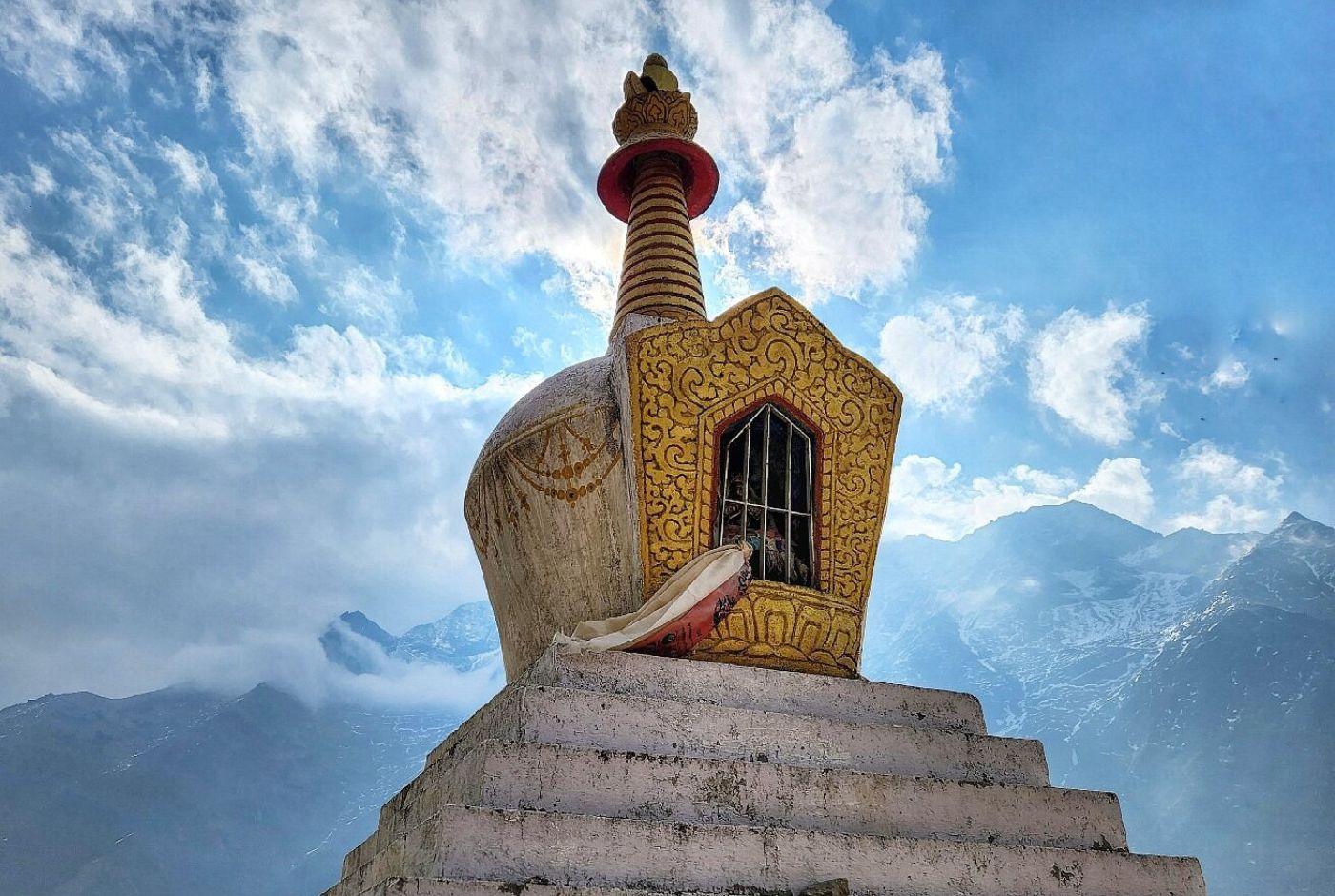
Festivals: Celebrating Faith and Community
Sherpa festivals are lively celebrations that generally center around their religion, i.e. Tibetan Buddhism. These events are observed with the families and their community, thus becoming exuberant communal events. There are primarily prayers, religious rituals, dances, and music at most Sherpa events.
Losar - The first day of the first month of the Tibetan and Sherpa Lunar calendar. ‘Lo’ means year, and ‘sar’ means new, so Losar is the New Year of Sherpas and Tibetans. It is generally celebrated in winter. To celebrate Losar, families first clean their homes to prepare for the new year. They set up grand offerings for their deities and perform rituals on the first day of the year. Then, feasts and celebrations follow to usher in the new year with positive vibes and ensure luck and prosperity.
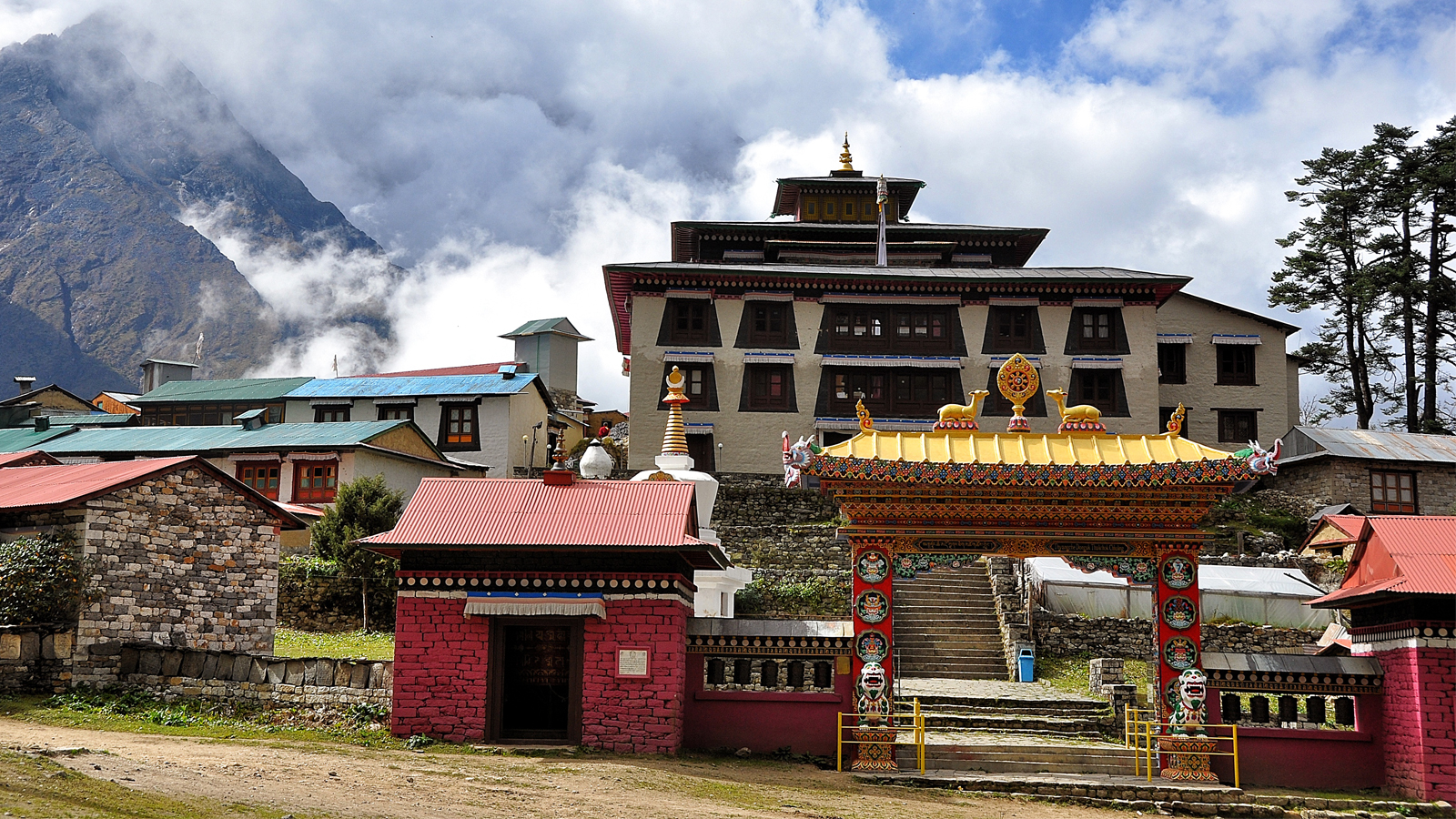
Dumji - Commemorating the birth of Guru Padmasambhava (Guru Rinpoche), the week-long festival of Dumji is celebrated earnestly by Sherpa communities. Dumji festival occurs in the fifth Tibetan month, so it takes place in May or June. Starting with prayers, rituals, and masked dances, the festival brings together members of the sherpa community to worship, feast, and enjoy the auspicious occasion.
Mani Rimdu - Mani Rimdu is one of the Sherpa community’s significant religious festivals, which take place annually in autumn. It is a grand ceremony with rituals like meditation, prayer sessions, fire puja, tantric rituals (tshogpa), and sacred mask dances. Tengboche monastery (Dawa Choling gompa) in Khumjung is the main venue for the festival, where locals of Solukhumbu gather to participate and acquire blessings. Mani Rimdu commemorates the advent of Buddhism in Tibet, which Guru Padmasambhava initiated.
Typical of Sherpa culture, these festivals reinforce their spiritual beliefs and strengthen their communal bond, thus contributing substantially to preserving their unique culture and identity.
Buddhism: The Heart of Sherpa Life
As one can see, sherpas are highly religious, and most of their day-to-day activities are governed by Buddhist principles. Whether in agriculture, mountaineering, or helping their neighbors and community, they are always ready to do their best for the common good. Some core values they live by are compassion and nonviolence. They believe in karma, rebirth, and reincarnation.
Monasteries, or gompas as sherpas call them, are the main places of worship for sherpas. These monastic centers have monks, nuns, and lamas who are key religious figures. They oversee the upkeep of these monasteries and fulfill the community’s needs by performing religious ceremonies and procuring blessings for all sentient beings. Every sherpa household has an altar where they place the idols of their deities and offerings. A daily offering consists of seven clean water bowls and a butter lamp. On auspicious days, they may make a grander offering of fruits, flowers, and other items.
Following their religion, sherpas relentlessly participate in puja ceremonies before their ascent of Mt Everest (Chongmolungma) because they believe the mountain’s guardian spirit must be appeased to ensure a safe journey.
Language: The Voice of the Sherpa People
The Sherpa language closely resembles the Tibetan language of Eastern Tibet due to their shared ancestry. Since the 13th and 14th centuries, when sherpa ancestors migrated to the Solukhumbu region in Nepal, they have passed down their spoken language orally through generations. However, there are no Sherpa scripts per se. They generally use Tibetan or Devanagari scripts. Sherpas are developing their own written language to have their scripts instead of relying on others.
Interesting Facts About Sherpas
Sherpas are the principal inhabitants of Nepal’s Solukhumbu region, where the mighty Mt Everest stands at a towering height of 8,849 meters between Nepal and Tibet. They are the brave people who have dwelled in the Khumbu region for centuries, becoming exceptional mountaineers due to their bravery and resilience. Today, sherpas have become an indispensable part of Everest expeditions.
10 facts about Sherpas:
- Origin of the name Sherpa: Sherpa is a Tibetan word meaning people from the East. ‘Shar’ means East, and ‘pa’ denotes people of that region. Since the ancestors of sherpas came from Eastern Tibet and settled in Nepal’s Solukhumbu more than 500 years ago, they are known as sherpas.
- High-Altitude Adaptation: Living in the mountainous areas of the Khumbu region for centuries, whose altitudes exceed 3,300 meters from sea level, Sherpas have adapted to the scarce oxygen levels because of their genetic traits like the EPAS1 gene. It enables them to use oxygen more efficiently.
- Mount Everest Connection: The Sherpa community has become indispensable for Everest expeditions. Since the first successful summit of Mt Everest by Tenzing Norgay Sherpa and Sir Edmund Hillary in 1953, sherpa guides and their contributions to mountaineering feats on Everest have made them renowned worldwide. Without them, Everest expeditions would be impossible as they not only guide the teams to the summit but also carry supplies, fix ropes, and take complete responsibility for climbers’ safety.
- Traditional Lifestyle: Since the fifteenth century, when sherpa communities living in the Solukhumbu regions began depending on subsistence agriculture, their primary source of livelihood were farming, animal rearing, and trade. Loading their goods on yaks and sheep, they traded food, wool, and salt with their neighboring country via Himalayan trade routes.
- Buddhism: As descendants of Tibetan ancestors who followed the Nyingma pa school of Tibetan Buddhism, sherpas are also mostly Nyingma pa. It is the oldest school of Tibetan Buddhism and was first introduced in Tibet by the great Guru Padmasambhava in the 8th century. Sherpas’ lives revolve around their religion, influencing their daily routines. They worship nature and believe they are abodes of deities and spirits. Before every ascent of Mt Everest, they perform rituals to appease the Mountain spirit and get their blessing for the climbers’ safety.
- Communal bond: Sherpas are a closely-knit ethnic group; they believe in sharing resources and supporting their families and neighbors in hardships. Their communal bond and efficient teamwork have resulted in their community’s development within a relatively short period. On your Everest expeditions, you can witness their amiable teamwork in providing the best care for their climbers.
- Language: Sherpa language is a derivative of the Tibetan language spoken in the eastern part of Tibet (Kham). Over the centuries, it has evolved by incorporating some aspects of Nepali and English, but it still retains its unique identity. Generally, the Sherpa language falls under the Tibeto-Burman language family. An interesting fact about the Sherpa language is that it has no scripts and relies on Tibetan and Devanagari to fill this gap.
- Sherpa settlements: Initially, sherpa communities dwelled in the Khumbu region of Nepal’s Solukhumbu district, and many still do. Having lived near Mt Everest for centuries, they became ideal for high-altitude mountaineering expeditions. Other sherpa communities in Nepal include Rolwaling, Helambu, Dolakha, and Solu. Apart from Nepal, sherpa communities can also be found in Tibet, India, Bhutan, the US (New York City), and so on.
- Impact on Tourism: Mountaineering and trekking in the Himalayas have immensely contributed to Nepal’s tourism sector. The Sherpa community has seen unprecedented financial and global growth due to the recognition of their work as mountaineering guides on Everest. Sherpas’ contribution to Nepal’s tourism sector is highly commendable. They should, therefore, receive better wages and more safety measures.
- Notable Sherpas: Tenzing Norgay Sherpa was the first to showcase sherpas’ expertise in mountaineering. He and Sir Edmund Hillary summited Mt Everest in the year 1953. Then began the trend of making and breaking records on Everest by enthusiastic sherpa climbers, which is still an ongoing process. Kami Rita Sherpa (55) holds the record for most Everest summits - 30 times as of 2024, Lhakpa Sherpa (52) has a record for most Everest summits by a Nepalese woman - 10 times as of 2022, and Pasang Lhamu Sherpa (late) is known for being the first Nepalese woman to reach Everest’s summit in 1993.
Sherpas and Their Deep Connection to Everest
Sherpas revere Mount Everest as a living entity. For them, it is Chongmolungma - the ‘Goddess Mother of the World.’ The profound spiritual connection with the Himalayas has shaped the cultural identity of Sherpas, who have lived in the shadow of Mt Everest all their lives.
According to Sherpa’s beliefs, mountains are abodes of guardian spirits, so one must pay homage to them before treading upon them. Everest expeditions begin after a puja ceremony, where Buddhist monks pray and make offerings to the Gods, seeking safe passage for the climbers. It is also a ceremony to appease the Mother Goddess (Everest) and seek her blessings for a successful expedition.
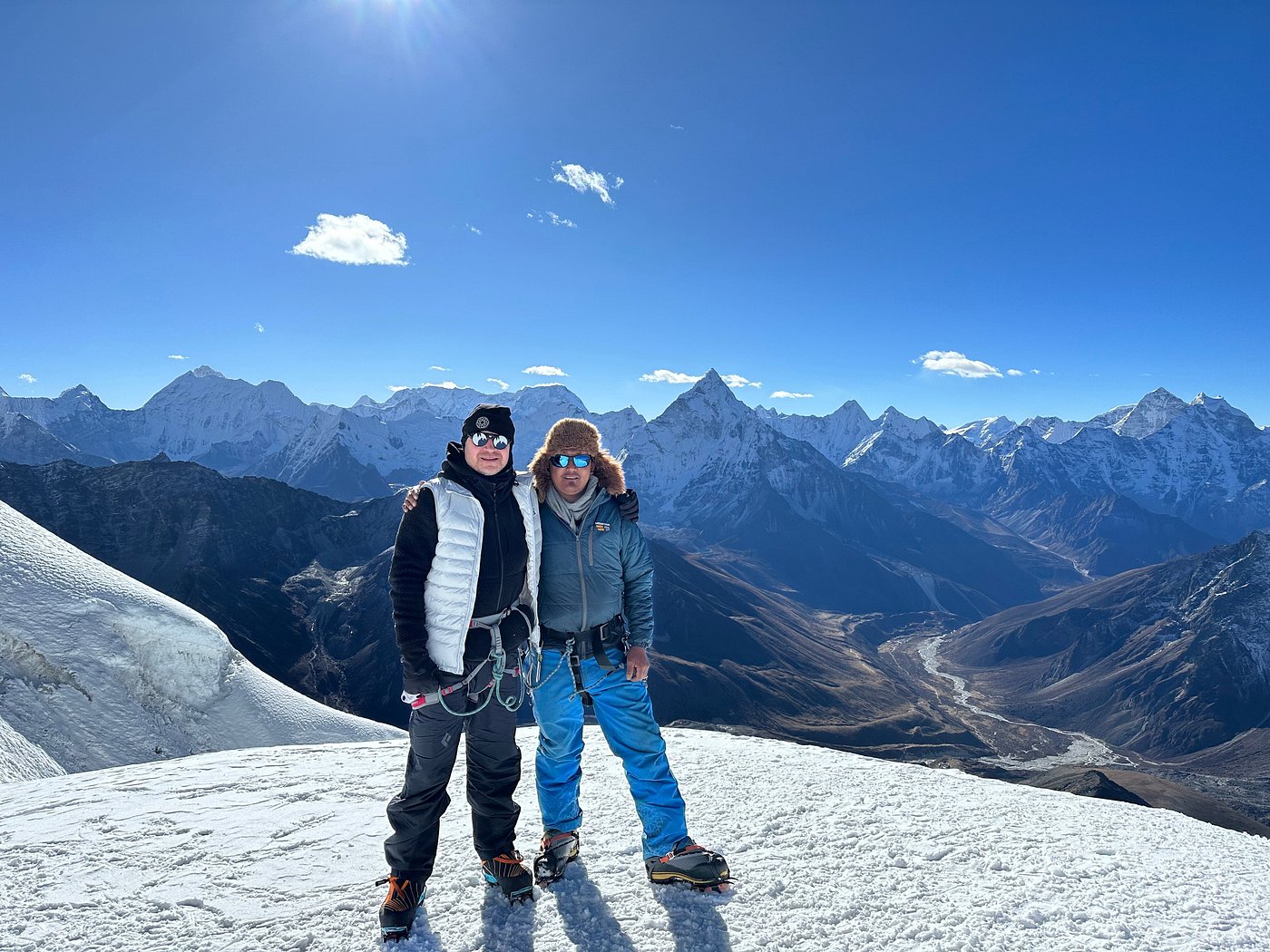
Since the fifteenth century, sherpas have lived in the Himalayas, making it their home away from home. Settling in the Khumbu (3,700 m - 4,300 m) and Solu (2,400 m - 3,100 m) regions of Nepal’s Solukhumbu district, they have endured the harsh climate of these high terrains, gradually adapting to this new land after migrating from Tibet’s eastern region. The prolonged mountain life has influenced Sherpa’s culture and traditions, besides making them a highly resilient group of people. It also became a key factor in making them renowned mountaineering guides known worldwide for their expertise and resilience. They found an ever-better alternative to subsistence agriculture through mountaineering opportunities, ensuring their families and communities a better future.
As sherpas have the utmost faith in Everest, they endeavor to conserve its pristine ecology by embarking on Everest’s cleaning missions from time to time. They remove the waste left on the mountain by climbers and take measures to keep Chongmolungma’s sanctity intact for generations.
Who are the Sherpas in Nepal?
Most travelers see Sherpas only as guides or porters. But to truly understand them, one must look deeper. They are mountain experts, legends carved from ice and rock, who master harsh terrains yet smile quietly against bitter winds.
In seasons of climbing, they guide with steady steps, leading strangers safely through trails that challenge even brave men. They carry heavy burdens without complaint, their strength silent, faces calm and eyes gentle. At night, the same men and women return to their fields, farming quietly beneath cold mountain skies, growing food to nourish weary visitors. Each crop tended is a story of survival, patience, and quiet strength.
When trails grow busy, Sherpas become businessmen, opening doors of tea houses to shelter travelers chasing dreams. Inside, fires burn warm and meals restore courage, served always with kindness and humility. Sherpas guard ancient traditions, stories whispered from elders about courage, faith, and respect for mountains that claim both triumph and tragedy.
More than porters or guides, Sherpas are true legends of the snow, humble masters of Everest, forever smiling quietly beneath mountains that test the courage of all who pass.
Sherpas are one of Nepal’s ethnic groups, predominantly living in the Himalayan regions of Nepal and Tibet. They are highly skilled mountaineers capable of living in high altitudes and are descendants of Tibetan ancestors. Their pivotal role in Everest expeditions has earned them the title of the world’s best mountaineering guides. Tenzing Norgay Sherpa, who first scaled Mt Everest in 1953 with Sir Edmund Hillary, was a legendary figure in mountaineering. He was the first Sherpa to achieve such a prestigious feat. Many sherpas followed in his footsteps and made numerous records in Everest and other mountaineering expeditions.
Why Can Sherpas Climb Without Oxygen?
Sherpas have naturally adapted to the thin air at high altitudes. They can make high ascents without oxygen supplements because their genetic traits (super athlete gene) allow the body to use the little oxygen they get more efficiently. Some unique genetic characteristics of sherpas include better hemoglobin binding capacity, faster oxygen delivery to tissues, and efficient mitochondrial function to increase energy production.
Why Are Sherpas Famous?
Sherpas are renowned for their mountaineering skills. Everest climbs are next to impossible without the exceptional guidance of sherpas, who perform essential and risky tasks like fixing ropes and carrying supplies for the climbers. Their endurance, adaptability in extreme altitudes, and knowledge of Mt Everest make them indispensable for Everest summit attempts.
Are Sherpa and Tamang the Same?
No, they belong to different ethnicities. Like Sherpas, Tamangs are also believed to be descendants of Tibetan origin, but there are opposing views to this theory as many researchers have dismissed this claim saying Tamangs are instead an indigenous ethnic group of Nepal. Hence, apart from a shared religion (Tibetan Buddhism), Sherpas and Tamangs differ historically, traditionally, and even based on their languages.
Which Caste is Sherpa?
Sherpas are an ethnic group belonging to the Bhotia people of Nepal. They are not Hindus, so they are not part of the Hindu caste system. Sherpas are Tibetan Buddhists.
Why is Sherpa Fabric Expensive?
Sherpa fabric is a synthetic material that looks and feels like sheep wool. It is generally used in clothing, outdoor gear, and blankets. Best for its warmth and insulating features, sherpa fabric has become a popular winter clothing choice. It is also suitable for trekking and mountaineering activities. The price of sherpa fabric is determined by its premium materials (synthetic), texture resembling sheep wool, and branding.
Why Are Sherpas Considered Happy?
The cheerful nature of Sherpas may leave you wondering what makes them so happy. It simply results from having deep faith in their religion (Buddhists), strong communal bond, reverence for mother nature, and profound dedication to their work as guides and climbers.
It is not like their lives are without hardships and setbacks, but they are resilient; they prefer a positive outlook on life and strive to do as many good deeds as possible. This positivity may come across as cheerful and explains why they are happy.
Is Sherpa a Nepali Brand?
Yes, it is a Nepali brand founded by a Nepali Sherpa. It specializes in outdoor wear and gear. You can find a variety of high-end mountaineering apparel and gear in the Sherpa outlets in Nepal.
How Healthy Are Sherpas?
Sherpas are very healthy as their lifestyle has influenced their physical constitution, so that despite their lean build-up, they are extraordinarily strong. There are, however, some factors that negatively impact their health. These are professional hazards, such as frostbite, altitude sickness, physical wear and tear due to carrying heavy loads over a long period, and minimal medical facilities in the remote Himalayas.
What is the Life of a Sherpa Like?
Sherpa’s life used to be simple in olden days. They used to practice subsistence agriculture and did small-scale trades with Tibet. Today, after the immense growth of mountaineering activities in Nepal, especially in the Everest region, Sherpas mainly engage in mountaineering work as guides, porters, or lodge owners. Some still practice agriculture, growing crops such as potatoes, barley, buckwheat, wheat, etc., and rear animals for meat and dairy. In colder seasons, like harsh winters, they migrate to lower altitudes and spend these months resting and recuperating.
Sherpa’s life is still simple. They work diligently to provide the best services on Everest to give their families a better future. They equally contribute to their community’s welfare and believe in helping people in need with what little they have. Their lives are highly influenced by their unwavering faith in Buddhism and spirituality, as in doing good deeds and worshiping Mother Nature.
Sherpa Life Expectancy:
It is a known fact that living in extremely high altitudes for a long time has adverse effects on our bodies, which even results in shorter life spans; sherpas are equally affected by the harsh climate around Everest (8,849 m). They have a shorter life span than Nepal’s average life expectancy.
Some factors contributing to Sherpa’s shorter life expectancy are the harsh living conditions and extreme weather of higher elevations (3,700 m - 4,300 m), limited access to health care, and their hazardous occupation.
How High Do Sherpas Live?
Sherpa villages in Khumbu are located at altitudes as high as 3,000 to 4,500 meters. Some sherpas live at relatively lower elevations like that of Solu, which is around 2,400 to 3,200 meters above sea level.
What is the Danger of Being a Sherpa?
As a sherpa mountaineering guide, chances of dangerous situations occurring on Mt Everest are incredibly high, as climbing the world’s tallest peak is challenging. The risks involved in a sherpa guide’s work include being struck by avalanches, falling into crevasses, getting altitude sickness, being struck by sudden weather changes, carrying heavy workloads on dangerous terrains, and having access to limited medical facilities.
Where can I meet Sherpa People and Experience Their Culture?
Sherpa communities are primarily based in the Khumbu region (3,700 m to 4,300 m) of Nepal’s Solukhumbu district. A trek to this enchanting landscape will allow you to experience Sherpa culture, taking you through their villages where you can interact with them and dwell among their historical places, such as Tengboche Monastery (1916). On the way to Mt Everest, some villages you will pass by include the bustling Namche Bazaar, Tengboche village where the sacred Dawa Choling gompa is situated, Pangboche, Khumjung, etc.
We at the Nepal Hiking Team offer the best Everest experience and a rare chance to observe and interact with the highly skilled sherpas. With our carefully designed Everest Trek Itineraries, you can reach the heartland of Sherpas and enjoy an incredible journey to the foot of Mt Everest.
Check out some of our hand-picked itineraries for Everest Base Camp trekking.
Everest Base Camp Trek (EBC) – The Quintessential Himalayan Journey
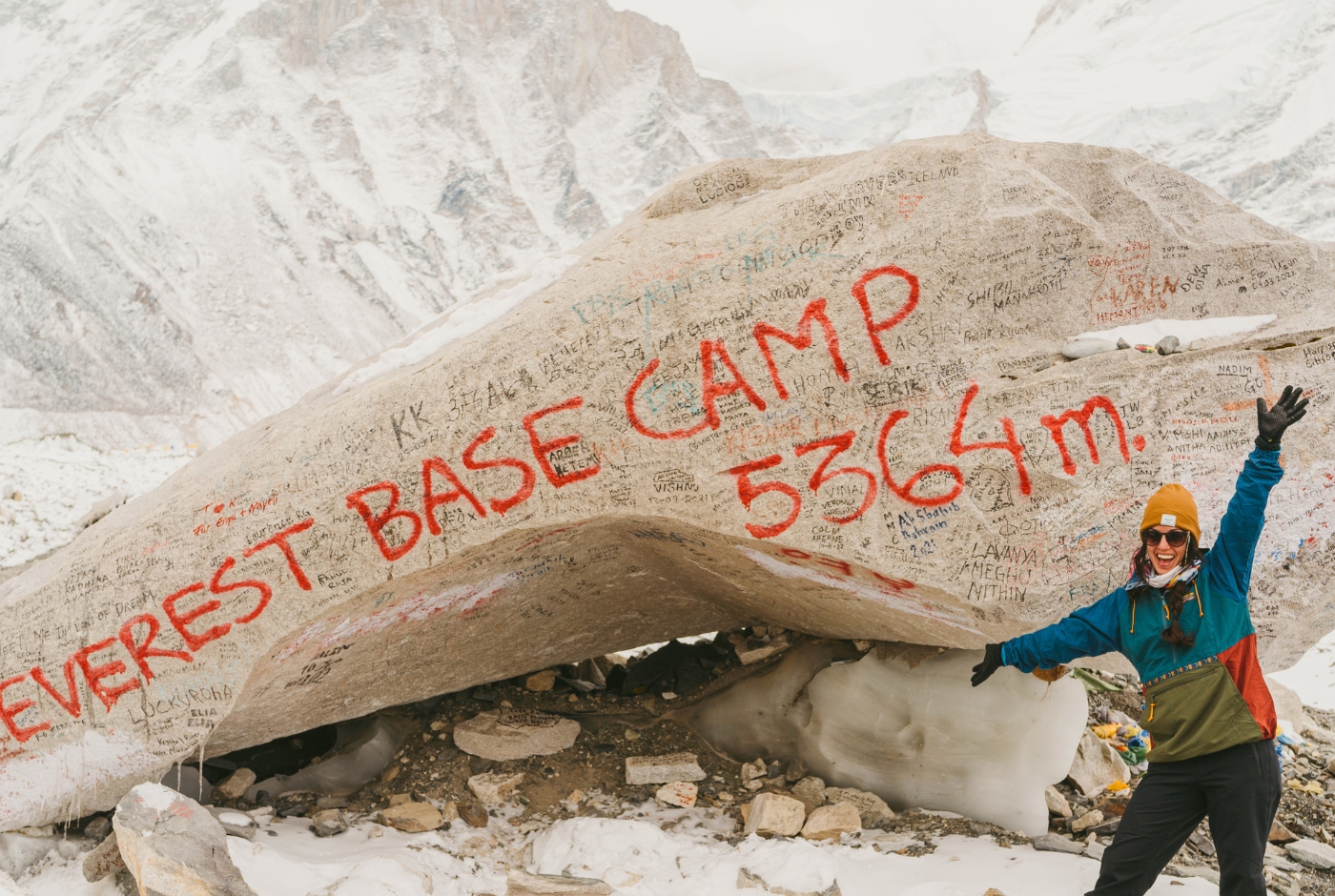
Duration: 14–16 days
Best Time to Visit: Spring (March-May) and Autumn (September–November)
Best features of the trek:
Visit the central commercial hub of Sherpas at Namche Bazaar, the gateway to Mt Everest.Pay your homage to Tengboche Monastery, Khumjung’s oldest and most sacred Buddhist monastery.Experience the warm hospitality of Sherpa people by staying at their lodges and teahouses. Interact with them to get a deeper understanding of their culture and customs.Witness the expertise of sherpa guides as you trek with them on the way to Everest Base Camp (EBC).
Gokyo Lakes Renjo La Pass Trek – A Serene Alternative to EBC
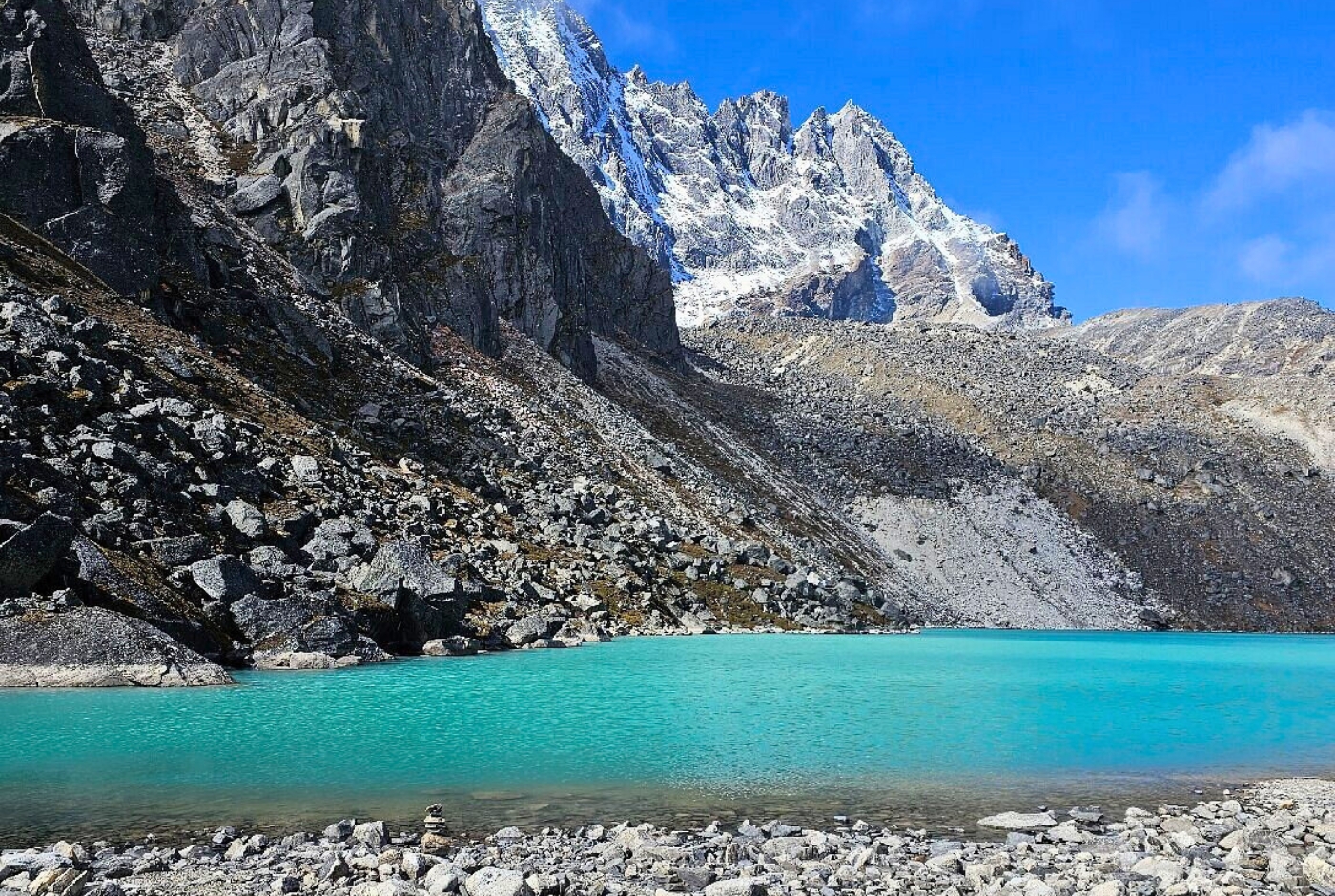
Duration: 16 days
Best Time to Visit: Spring and Autumn
Highlights:
Explore the remote sherpa settlements of Khumbu for a peaceful trekking experience.Witness the enchanting blue waters of Gokyo Lakes and a panorama of Mt Everest from Gokyo Ri (5,357 m). Experience Sherpa culture in a serene landscape tucked away from the crowded trails of EBC.
Everest Three Passes Trek – The Ultimate High-Altitude Adventure
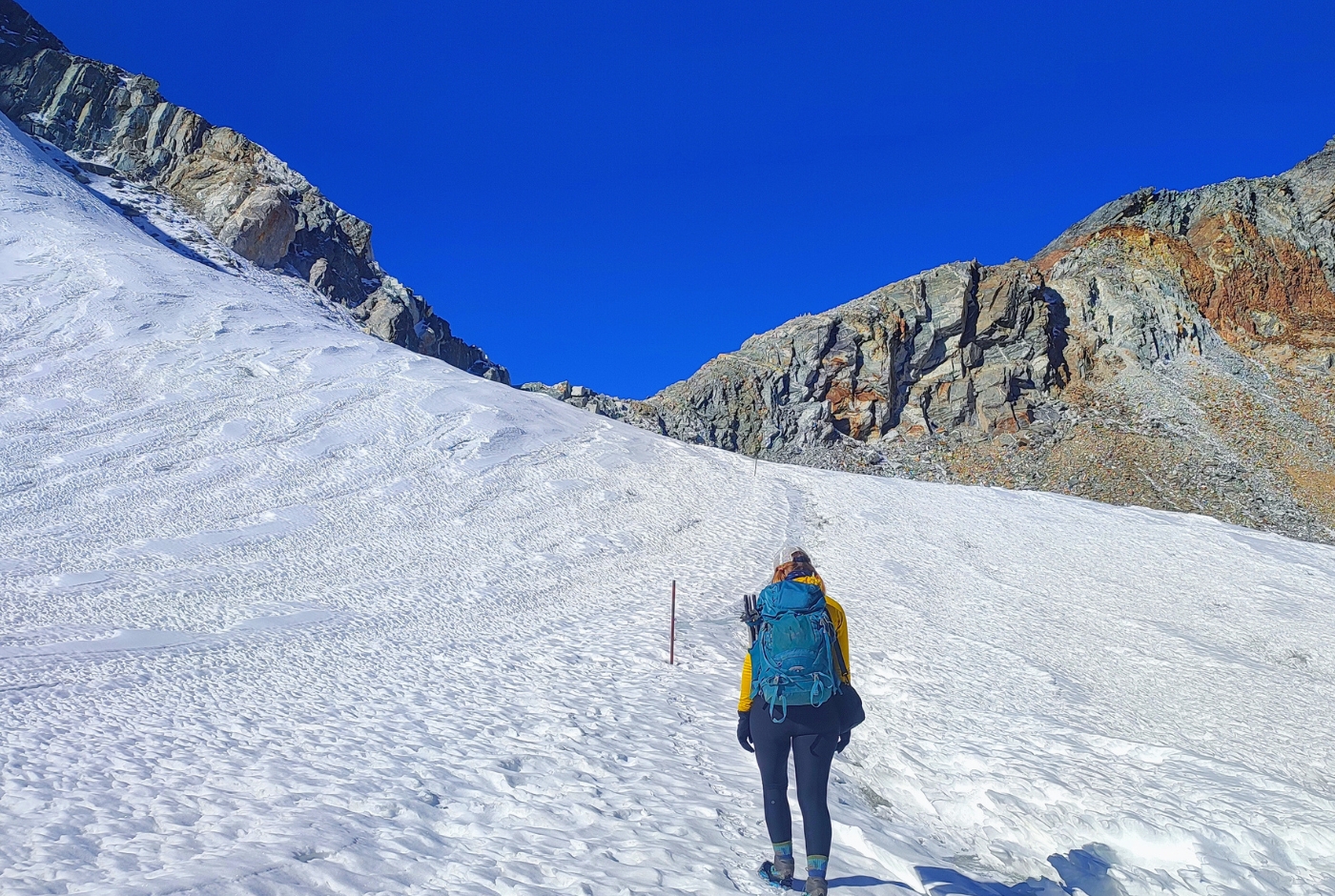
Duration: 22 days
Best Time to Visit: Spring and Autumn
Highlights of the Trek
Embark on this ultimate all-inclusive trek of Everest, where you will visit Everest Base camp, Gokyo Lakes, and some of the remote Sherpa villages. Cross the three mountain passages of the Everest region, namely Kongma La (5,540 m), Cho La (5,420 m), and Renjo La (5,360 m), for a thrilling mountaineering challenge.Share spaces with some of the most isolated Sherpa communities of Nepal.
Obtain first-hand knowledge of the rich Sherpa culture and legendary mountaineering heritage with the Nepal Hiking Team. Our well-planned Everest trek itineraries perfectly blend mountain adventure and in-depth cultural immersion. Reach out to us for the most transformative journey to Everest.



